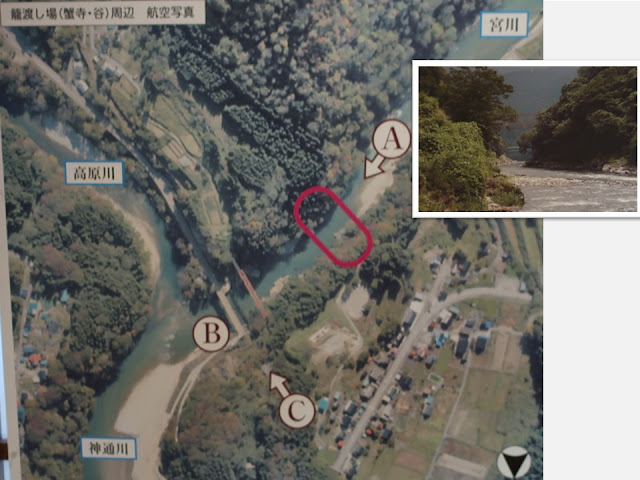The museum is near the ex-checkpoint site
which was at the border of Toyama and Hida. The checkpoint controlled
travelers and materials between the two regions. People including sick
people passed, and fishes of Toyama Bay also passed and were brough to Hida
which is a mountainous region. Interestingly enough, there was a famous
vehicle like a ropeway; it brought a traveler to the other side of the valley.
西猪谷関所があった場所に立つ資料館です。関所は、飛騨高山と越中富山を結ぶ飛騨街道の国境にあり、その通行を管理していました。富山湾で獲れた鰤、病人、さまざまな人や物が通行していました。また、駕籠に乗せた旅人をロープウェイの仕組みで峡谷を渡す名物設備がありましたよ。
Buddhist statues of Enku (1632-1695), who was a renowned traveling sculptor, are displayed. It has such a kind face.
エントランスホールには美濃に生まれ東日本を旅しながら多くの仏像を残した円空(1632-1695)の作品が展示されています。やさしいお顔ですね。
The quantity of salted fishes (yellowtails) transported is shown in the exhibition room above. The amount of the large yellowtails was 2513, and the one of the small ones was 2174. Those were highly valued as feast on the New Year Day in the mountainous regions. The name of “yellowtail” in Japanese changes with growth; it is considered as a career advancement of the fish.
展示室に入ると三つのルートがあった飛騨街道で運ばれた鰤の輸送量がパネルで紹介されています。平均で大鰤が2513本、小鰤が2174本も運ばれました。鰤は出世魚として飛騨や信濃では年越しの膳を飾るご馳走です。
There were checkpoints at the both side of the Jinzu River.
関所は神通峡の両岸に建てられていました。
There is a model of the checkpoint. Displayed old documents are more interesting.
関所の模型がありますが、文書が興味深いです。
The most frequent passengers were local government officers or staff who traveled to the offices in the other regions. In addition, medicine vendors, storytellers, entertainers, groups of sumo wrestlers, practitioners of martial arts, pilgrims to Ise or Minobu, patients of hot spring cure and so on passed. Their passports are displayed.
関所を通過した中で一番多いのが富山藩と高山陣屋を行き来した人々。他に、売薬行商、軍談師、芸人、相撲一行、武者修行の人々、伊勢や身延山への参詣の人々、湯治に行く人々らが関所を通りました。過書(関所通行の許可証)が展示されています。
The document on the right was a stamp book to compare the seals to on passport. Although it seemed to be a strict operation, but it was flexible. An entertainer pleaded to pass the checkpoint; he proved his identity by showing his performance. He passed!
The document on the left was a record of deported criminals.
右は、過書の印鑑を照合するための御印鑑帳。しかし、「このように厳しい反面、番人の手心で過書なしで通した例が記録に残されています。芸人が芸を見せるから通して欲しいというので、それを見て通しています」。安宅の関の伝統でしょうかねえ。
左は国外通報した犯罪者を記録した追放留です。
The paper above was a passport of a merchant who went to Kagoshima (about 800 km away in a straight line) to sell medicine. Toyama have been a production center of medicine, which was an important source of income of Toyama.
鹿児島まで行く売薬商人・儀助さんに発行された往来手形です。折りたたんだ跡がないので複製でしょうかねえ。富山の薬売りは有名です。富山藩の重要な収入源でした。
Materials also passed the checkpoint. Tariff was collected, of course. If a merchant couldn’t pay the tax, he had to leave a memorandum; he paid when he returned to his home town. It’s a flexible operation.
関所には物資も行き交います。関所ではしっかり通行税を徴収していますよ。商人が払えない場合は一筆入れて帰りに納めました(左下)。融通がききますねえ。
A sick person was sent to their home town by palanquin. The checkpoint prepared a palanquin to the neighboring village. Then, the village sent the person to the next village by palanquin. What a kind system it was! A six-year-old boy, who made a pilgrimage with parents, was sent to his home town which was around 400 km away by the system. His parents died while traveling. The record says twenty-five people were sent to their home town from 1829 to 1860.
病気になった旅人は、駕籠に乗せてもらい、村から村へと順次送っていきました(村継ぎ、村送り)。奥州からの旅人や善光寺参りの途中で親が病死した6歳の子もいます。あたたかい制度ですね。福祉事業です。1829年から1860年までの32年間で25人が送られています。
A traveler got on a cage like a ropeway to cross the valley (upper left). Cattle and horses which carried loads crossed the shallows at downstream. Why people used the ropeway? I guess they could cross the river even when water rose.
ロープウェイで谷を渡る(左上)のですが、荷物を積んだ牛馬は下流の浅瀬を渡ったとのこと。なんか腑に落ちませんが、ロープウェイなら水量が多いときでも渡れますね。
There is a model of the ropeway. You can get on the cage and can see the view in VR (upper left). Parts are displayed (lower right). The job pulling the rope was imposed on villagers.
街道一の難所・籠渡しはVRのアトラクションになっています(左上)。使われていた部品も展示されていますよ。綱を曳くのは近村の人たちの仕事でした。
There was a ropeway at point (A); there were three points in total.
蟹寺と谷の渡しの写真(A)、狭い谷です。籠の渡し場は三カ所にありました。
The panel says that the daimyo lord had a tour to see the ropeway a few times. He contributed to financial reconstruction, and built a chic villa. (Toyama Municipal Folk Museum).
加賀藩の支藩・富山藩の前田利保公が何度か籠渡しを見物しています。利保公は江戸後期の藩主、藩の財政を立て直しつつ、別荘・御涼所(富山市郷土博物館)も建てた粋な藩主です。
The ropeway became well-known and was depicted in pictures and poems. So, the place became a scenic spot.
籠の渡しは絵に描かれ、歌に詠まれて景勝地になりました。
Actually, they used the ropeway in the Edo period (1603~1868) due to military and security reason.
A drawbridge was constructed in the
following modern era (1872). The road width was enlarged from 1 meter to 5.4
meters, so wagon could cross (①). Then, horse tramway was constructed
(②). The horse-drawn streetcar carried loads which were two to three times
heavier than wagon did. It carried from 1.5 to 2.2 tons of loads.
In 1934, the railway finally started
operation (③, the photo was taken in 1966). There is also a two-lane
road (④) now. It is convenient now.
実は、橋を架けずに籠の渡しにしていたのは、軍事・治安上の理由だそうです。
1872(明治2)年に刎橋(はねはし)が架けられました。1886年には道幅が1mから5.4mに拡幅され荷馬車が通れるようになりました(①)。次いで、馬車軌道が設けられ、荷馬車の2~3倍(1.5~2.2トン)の荷をはこべるようになりました(②)。
1934年、ついに鉄道(高山本線)が開通(③、写真は1966年の国鉄神岡線開通)。今は二車線の国道(④)も走っています。便利になりました。
Official
website: https://www.city.toyama.lg.jp/bunka/bunka/1010547/1010551/1010554/index.html
(in Japanese. Automatic translation is attached), accessed in March, 2025
Visited in September, 2024
Previous post (museum in the same prefecture, base of the mountain worship): Tateyama
Museum of Toyama and Mt. Tateyama(2/2)、立山博物館と立山 (part2)
Next post (Takayama City in the neighboring prefecture): Takayama Festival in spring and Takayama Museum of History and Art、春の高山祭と飛騨高山まちの博物館
















Comments
Post a Comment